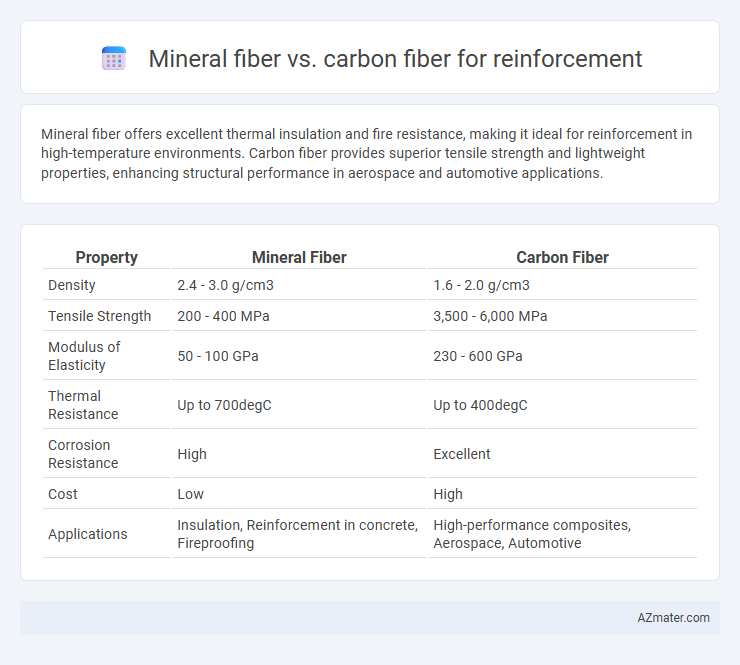Mineral fiber offers excellent thermal insulation and fire resistance, making it ideal for reinforcement in high-temperature environments. Carbon fiber provides superior tensile strength and lightweight properties, enhancing structural performance in aerospace and automotive applications.
Table of Comparison
| Property | Mineral Fiber | Carbon Fiber |
|---|---|---|
| Density | 2.4 - 3.0 g/cm3 | 1.6 - 2.0 g/cm3 |
| Tensile Strength | 200 - 400 MPa | 3,500 - 6,000 MPa |
| Modulus of Elasticity | 50 - 100 GPa | 230 - 600 GPa |
| Thermal Resistance | Up to 700degC | Up to 400degC |
| Corrosion Resistance | High | Excellent |
| Cost | Low | High |
| Applications | Insulation, Reinforcement in concrete, Fireproofing | High-performance composites, Aerospace, Automotive |
Introduction to Fiber Reinforcement Technologies
Mineral fiber and carbon fiber represent two primary materials used in fiber reinforcement technologies, each offering distinct properties for structural enhancement. Mineral fibers, such as basalt or glass fibers, provide excellent thermal resistance and cost-effective reinforcement for concrete and composites. Carbon fibers exhibit superior tensile strength and stiffness, making them ideal for high-performance applications requiring lightweight and durable reinforcement.
Overview of Mineral Fiber Reinforcement
Mineral fiber reinforcement, commonly made from basalt or glass fibers, offers high thermal stability, excellent corrosion resistance, and cost-effective durability in composite materials. These fibers improve mechanical strength and impact resistance while providing fire retardant properties, making them suitable for construction and infrastructure applications. Compared to carbon fiber, mineral fibers are heavier but deliver enhanced chemical resilience and better performance in high-temperature environments.
Overview of Carbon Fiber Reinforcement
Carbon fiber reinforcement offers superior tensile strength and stiffness compared to mineral fiber, making it ideal for high-performance structural applications. Its lightweight nature enhances load-bearing capacity while reducing overall material weight, contributing to improved efficiency in automotive and aerospace industries. Excellent corrosion resistance and fatigue durability further extend the lifespan of composite materials reinforced with carbon fiber.
Comparative Mechanical Properties
Mineral fiber exhibits high tensile strength and excellent thermal resistance, making it suitable for reinforcement in environments exposed to high temperatures. Carbon fiber offers superior stiffness-to-weight ratio and higher tensile modulus, providing enhanced rigidity and load-bearing capacity for structural applications. While carbon fiber outperforms in mechanical strength and fatigue resistance, mineral fiber maintains cost-effectiveness and improved impact resistance in composite materials.
Durability and Longevity
Mineral fiber exhibits exceptional resistance to chemical corrosion, high temperatures, and moisture, enhancing its durability in harsh environments. Carbon fiber offers superior tensile strength and fatigue resistance, contributing to longer structural lifespan under cyclic loading. When comparing longevity, carbon fiber typically outperforms mineral fiber due to its exceptional mechanical properties and lower susceptibility to environmental degradation.
Cost Analysis: Mineral Fiber vs Carbon Fiber
Mineral fiber reinforcement offers a cost-efficient alternative to carbon fiber, with prices typically ranging from $1 to $5 per pound compared to carbon fiber's $10 to $20 per pound, making it more suitable for budget-sensitive construction projects. Mineral fibers provide adequate tensile strength and durability at a fraction of the cost, although carbon fiber's superior strength-to-weight ratio justifies its premium in high-performance applications. The significant difference in raw material and manufacturing expenses positions mineral fiber as a practical choice for large-scale reinforcement where cost constraints outweigh maximum strength requirements.
Environmental Impact and Sustainability
Mineral fiber and carbon fiber offer distinct environmental impacts and sustainability profiles for reinforcement applications. Mineral fibers, often derived from abundant natural materials like basalt or glass, typically have lower embodied energy and are more recyclable, reducing landfill waste and carbon emissions during production. In contrast, carbon fiber provides superior strength-to-weight ratios but involves energy-intensive manufacturing processes and challenges in recyclability, resulting in a higher carbon footprint and greater environmental concerns over its lifecycle.
Application Areas and Use Cases
Mineral fiber, commonly used in thermal insulation and fireproofing applications, offers excellent heat resistance and sound absorption properties, making it ideal for construction and industrial settings. Carbon fiber is favored for high-performance reinforcement in aerospace, automotive, and sports equipment due to its exceptional strength-to-weight ratio and stiffness. While mineral fiber excels in protective and insulating roles, carbon fiber is predominantly chosen for structural components requiring lightweight durability and high tensile strength.
Installation and Handling Considerations
Mineral fiber offers easier handling due to its lighter weight and flexibility, reducing installer fatigue and enhancing maneuverability during placement in concrete structures. Carbon fiber, while significantly stronger and more durable, requires careful handling to avoid damage to its brittle fibers and often demands specialized training and protective gear to prevent skin irritation or respiratory issues. Installation speed for mineral fiber tends to be faster, but carbon fiber's superior tensile strength can justify the additional care and time required in more demanding structural reinforcement applications.
Conclusion: Choosing the Right Reinforcement Fiber
Mineral fiber offers excellent fire resistance and thermal insulation, making it ideal for applications requiring safety and temperature control, while carbon fiber provides superior tensile strength and stiffness suited for high-performance structural reinforcement. Selecting the right reinforcement fiber depends on project-specific factors such as load requirements, environmental exposure, and cost constraints. Evaluating these parameters ensures optimal durability and efficiency in construction or manufacturing applications.

Infographic: Mineral fiber vs Carbon fiber for Reinforcement
 azmater.com
azmater.com